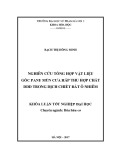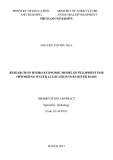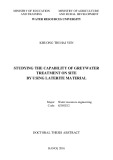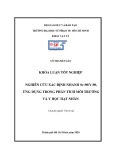
MINISTRY OF EDUCATION AND
TRAINING
MINISTRY OF AGRICULTURE AND
RURAL DEVELOPMENT
WATER RESOURCES UNIVERSTY
DOAN THI NOI
RESEARCH ON RAINFALL - RUNOFF CHANGES AND PROPOSE
SCIENTIFIC METHODOLOGY TO COMPUTE DESIGNED FLOOD
FOR TRANSPORTATION IN NORTHEAST MOUTAINOUS REGION
OF VIET NAM
Specialization: Hydrology
Code No: 62-44-02-24
DOCTORAL THESIS SUMMARY
HA NOI, 2016

Research has been completed at Water Resources Universty
Advisor 1: Assoc. Prof Ngo Le Long
Advisor 2: Assoc. Prof Hoang Thanh Tung
Reviewer No. 1 : Prof Tran Thuc
Reviewer No. 2 : Assoc. Prof Tran Dinh Nghien
Reviewer No. 3 : Dr. Nguyen Lap Dan
This Doctoral thesis will be defended at the meeting of the Universty Doctoral
Committee in Room No … on…
...............................................................................................................................
...............................................................................................................................
This dissertation is available at:
- The National Library
- The Library of Water Resources University

1
INTRODUCTION
1. Rationale
Transportation plays a significantly role in national development, it is
necessary to complete and modernize transportation system. The country has
largely invested annually in new construction, upgradation and expansion of
transportation system for commercial, cultural and economical intercourses
both locally and internationally. In Vietnam, with more than 2/3 area is
mountainous area, but more than 70% road length is in this area.
Mountainous roads are mainly III-V grades while design and construction of
drainage works (bridge, culverts and ditch) have not been paid attention to as
well as limitation on calculation of hydrological and hydraulic features. Under
the effect of tropical monsoon climate with increasing extreme rainfall that
heavily damaged the transportation works. One of the main courses
significantly affecting sustainability and resilience of the drainage and
causing falling of negative and positive talus, floating of bridge and
culverts, and damage of bridge piers is effect of extreme rainfall in which
incorrect or improper calculation of design flood is the main cause. Vietnam
Standard TCVN 9845:2013 (based on QP.TL C-6-77) introduces a number of
methods for calculation of design flood based on rainfall such as: Intensity
limits and Xokolopxky originated from Russian authors of which many
parameters are not suitable with Vietnam conditions and their verification is
difficult therefore, results of the calculation may not be suitable to the actuality
and lead to dissatisfaction of apertures of the highway drainage structures. The
lack of rainfall and flow data, especially shorter period data, also causes
difficulty during calculation of design flood. Therefore, dissertation “Research
on rainfall - runoff changes and propose scientific base for calculation of

2
design flood for transportation in North-East mountainous Region of Viet nam”
is urgently needed.
1. Research objectives
To study rainfall-runoff changes, to downscale rainfall and surface over time
and space, and to establish scientific base for calculation of design flood for
transportation structures.
2. Scope of the study
- Scope of study: Bac Kan and Lang Son provinces in the Northeast
mountainous areas of VietNam;
- Object of study: design rainfall and design flood for drainage structures on
National Highway QL3, 3B, 279, 3, 4A, 4B, and 1A in the studied area.
3. Study approach and methodology
3.1. Approach
To achieve the proposed target, necessary documents, general studies on
rainfall-runoff changes, methods for calculation of design flood for
transportation locally and internationally are collected to further select
appropriate approaches that are inheritable and yet ensure creativity in research.
3.2. Methodology
Methods used in the dissertation include: i) analysis, statistics, and selective
inheritance of related studies; ii) remote sensing and GIS has been used to
establish basins in mathematical models and to develop maps as scientific
base for proposal of methods for design flood calculation; iii) mathematical
models and case studies have been carried out to propose suitable methods
for design flood calculation transportation structures in the Northeast region
of Vietnam.

3
4. Scientific and practical meanings
Results achieved from the dissertation has high practical meaning for having
partially solved the current difficulties in calculation of highway hydrology.
The study on rainfall-runoff changes in the Northeast region and
establishment of scientific base for calculation of design flood for
transportation structures have scientific meaning in approaching modern
calculation methods and is premise for development of calculation
procedure, which is suitable to Vietnam conditions.
5. New contributions
- Improved current methods for design flood calculation for drainage
structures in transportation taking into account of rainfall - runoff
changes and of detailed ground surface conditions by application of
modern techniques such as hydrological models and GIS;
- Developed calculation program for design floods for drainage
structures in transportation.
6. Contents of the dissertation
In addition to the Introduction, Conclusions and Recommendations, the
dissertation consists of 03 chapters:
Chapter
1: Literature reviews on calculation of design flood for transportation
works.
Chapter 2: Development of scientific base for calculation of design floods for
transportation works in the Northeast region of Vietnam.
Chapter 3: Case studies and recommendation of design flood methods for
transportation works.














![Ô nhiễm môi trường không khí: Bài tiểu luận [Nổi bật/Chi tiết/Phân tích]](https://cdn.tailieu.vn/images/document/thumbnail/2025/20251011/kimphuong1001/135x160/76241760173495.jpg)







![Ứng dụng kỹ thuật trao đổi ion trong điện phân: Bài tiểu luận [chuẩn nhất]](https://cdn.tailieu.vn/images/document/thumbnail/2025/20250829/sonphamxuan1808/135x160/97341756442892.jpg)



